by Tom Gaylord, a.k.a. B.B. Pelletier
Announcement: Wesley Santiago is this week’s winner of Pyramyd Air’s Big Shot of the Week on their airgun facebook page. He’ll receive a $50 Pyramyd AIR gift card. Congratulations!
Wesley Santiago is this week’s Big Shot of the Week on Pyramyd Air’s facebook page. He’s holding an AirForce Airguns Talon SS air rifle.
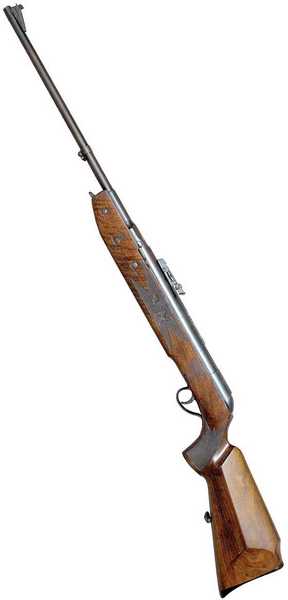
Falke 90 before restoration.
A funny thing happened as I was writing this report. I mentioned at the end of the last part that I was thinking of restoring the stock that was so beat up, and many readers raised their voices in unison to say “NO!” Okay, I admit that I’m not the finest woodworker in the world, but you don’t all need to agree so emphatically. And so quickly!
Kevin wrote me a message, pleading and trying to reason with me that this poor old rifle had suffered enough and deserved the touch of a master’s hand rather than the collateral damage I would no doubt inflict. And he even provided me with a name — Doug Phillips.
Doug lives in Houston, as it turns out, (I live in the same state), and he works at a business he calls DamagedWoodstocks, which sounded exactly like what I had. How did he know? I contacted him after looking over the photos on his website. Turns out that he works with a lot of damaged airgun stocks, and he can work near-miracles.
I emailed him and sent along some photos to give him an idea of the scope of the job. But by my own ignorance, I omitted the really bad news and poor Doug had to discover that for himself after quoting the job. I did tell him he could revise his estimate after he saw the stock because I don’t think either of us appreciated just how much work was going to be involved. So, this report is my penance for telling such a big fib — even if it was by omission and because I don’t know enough about woodworking to start a good campfire.
The stock
The Falke 90 stock was covered with scars, gouges and cracks; it also had missing wood and the initials of some former owner. It was so ugly that it detracted from the fact that the airgun it held is rarer than a One of One-Thousand Winchester rifle! If this were a firearm, it would be worth thousands of dollars. It would be one of those you see on TV where they say, “Even in this condition, this rifle is so rare that it still commands a high price.” But it isn’t a firearm. It’s an airgun, and I was unable to get any bites on it when I offered it for $250 at the 2012 Roanoke Airgun Show a couple months ago. Several major collectors looked at it sitting on my table as though it was a carrier of the Black Plague. That why I resolved to do something.
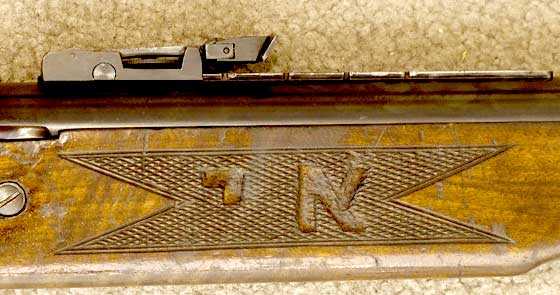
These initials were stamped into the left checkered panel of the rifle. I considered this the major damage, but I was wrong.
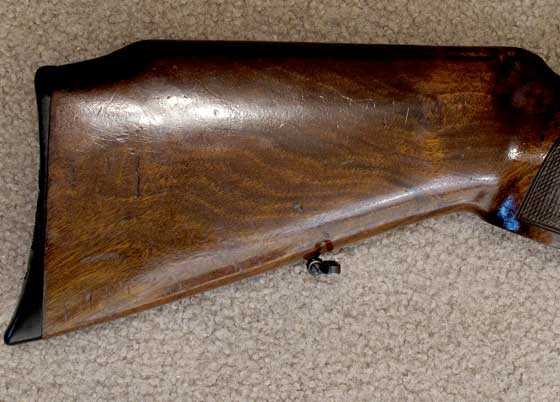
The right side of the butt shows a pleasing grain, but the dark stain and heavy varnish obscure it.
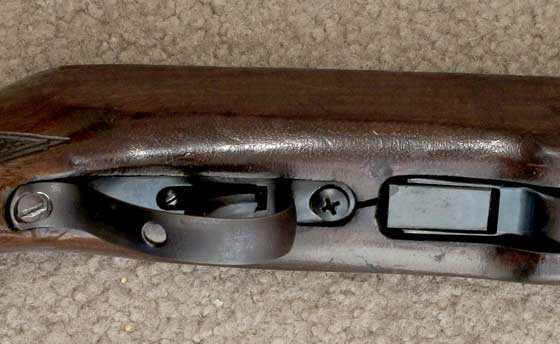
That crack in front of the triggerguard is the real problem with this stock. Under the triggerguard plate, about 90 percent of the original wood is missing!
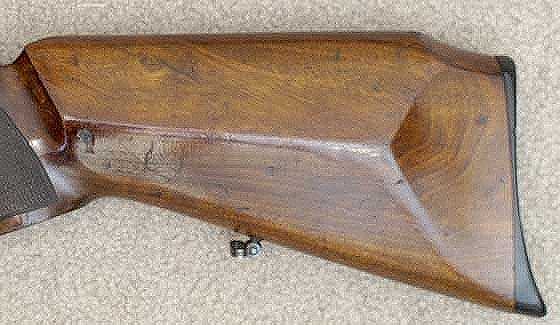
This view of the left side of the butt shows the general poor condition of the wood. See the deep gouges that had to be dealt with? They’re all over the stock.
These are a few selected views of the gun that went to Doug. I have more, but to keep this report manageable, I’m not showing them.
After Doug received the stock, we chatted via email and I learned that the trigger plate inlettting that I shrugged off was his biggest concern. I shrugged it off because I reckoned that nobody could ever do anything about it anyway, so why whine over something that can’t be fixed? That was when I found out what kind of guy Doug is. He said he would study the stock for several days and then formulate a repair plan.
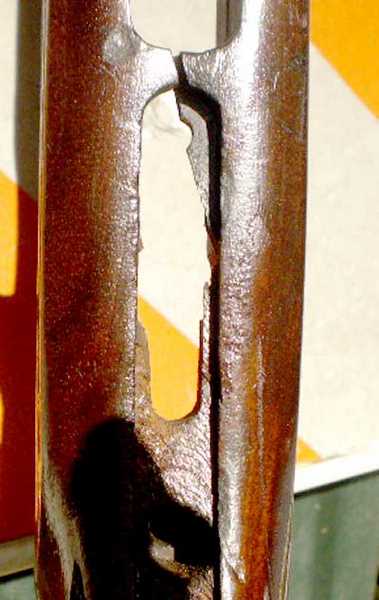
This is what Doug was faced with. Ninety percent of the trigger plate in the stock is missing.
Good to his word, he did contact me a couple days later and said that he had a plan for the stock. We talked a bit about how I would like it to look when it was finished, and I opted for a warmer, lighter color for the wood and not so much shiny finish over everything. That stuff can make a masterpiece look like cheap plastic!
A week later, Doug sent me a report with a couple photos. In three of them, I saw the great lengths he was going to in order to fix the rifle’s inletting at the trigger. As it turned out, he fashioned a metal plate and set it in place for the inletting of the trigger group. Then he epoxied it in place. It is also held in place by metal pins.
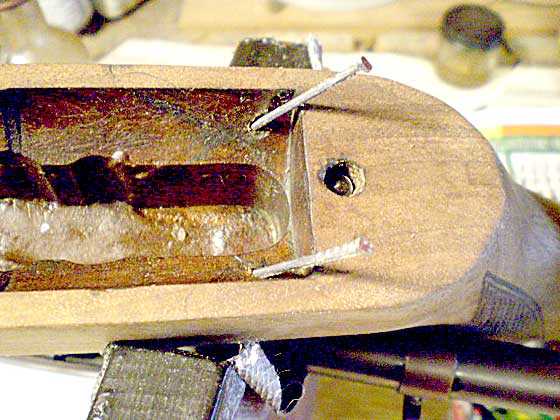
The trigger plate was completely rebuilt, with steel pins to reinforce it.
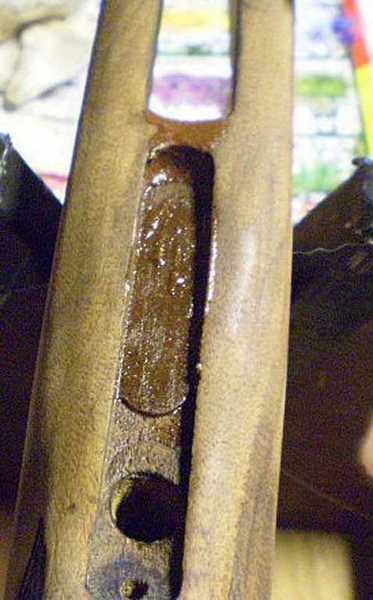
Once the plate was in position, it was epoxied in place.
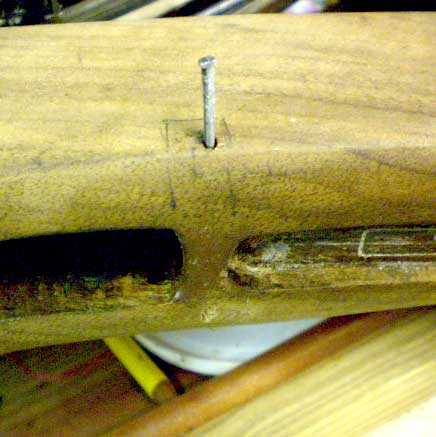
To strengthen the area where the crack was, he put in a cross pin.
I screwed up!
I was having the work done by someone else, so how could I screw up the job? Well, funny you should ask. Doug told me that he needed the rifle’s action to measure and check the new inletting, so I quickly wrapped it up and sent it off. And quickly is the clue, because I didn’t pack the 6 lb., 10 oz. action well enough. By the time it travelled 400 miles to him, it had punched a hole in the end of the box and dented the end of the steel end cap. Sure it was insured, but try finding replacement parts for a Falke 90!
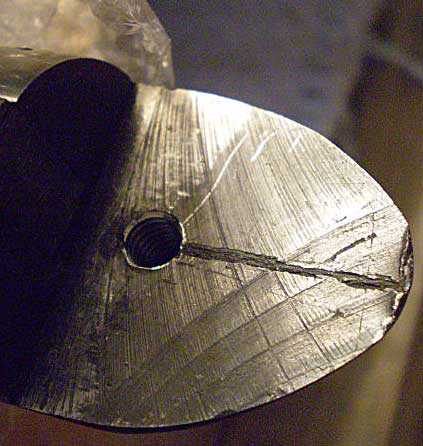
Due to my poor packing, the Falke action punched through the side of the box and dented the end cap.
Doug repaired the dent so it’s not visible when the rifle is assembled. It wasn’t part of what he signed up to do — just a dirty little job he inherited from me.
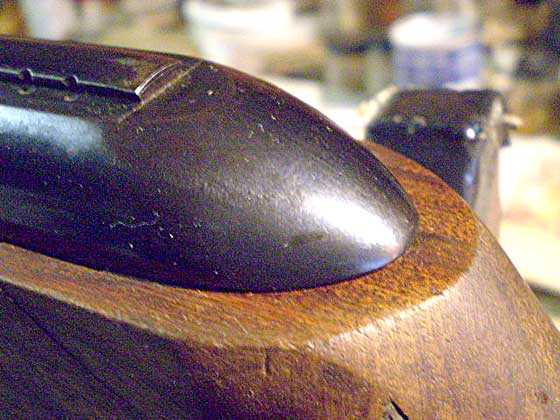
You can’t tell the end cap was ever dented.
The initials
The things I worried about the most were probably some of the easier fixes for Doug — at least in retrospect. He used sawdust from the stock mixed with epoxy to fill in the depressions, then he smoothed down the top of the repair and recut the checkering just like the original. He even left flattened diamonds, so the work looks vintage and not new.
The staining of the repaired panel was a very touchy part of this repair, because epoxy doesn’t accept stain like the wood around it. But he managed to do it perfectly. I cannot tell where the initials ever were.
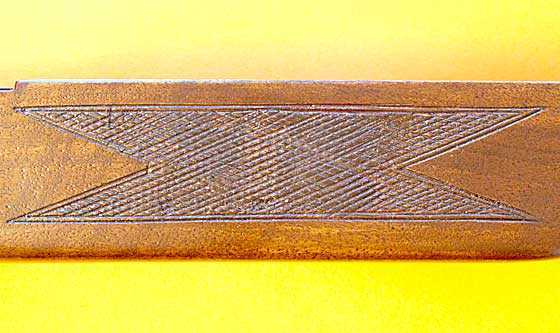
This is the panel that had the initials. They’re gone, and it doesn’t look like a new repair. The man is brilliant!
The gun is back
Doug worked diligently on this project, and it wasn’t too long before I had the rifle back in my possession. I expected the work to take much longer than it did, and I’m not promising that Doug will be able to complete every job this fast. But he communicated with me often, and I appreciated that as much as the work, itself.
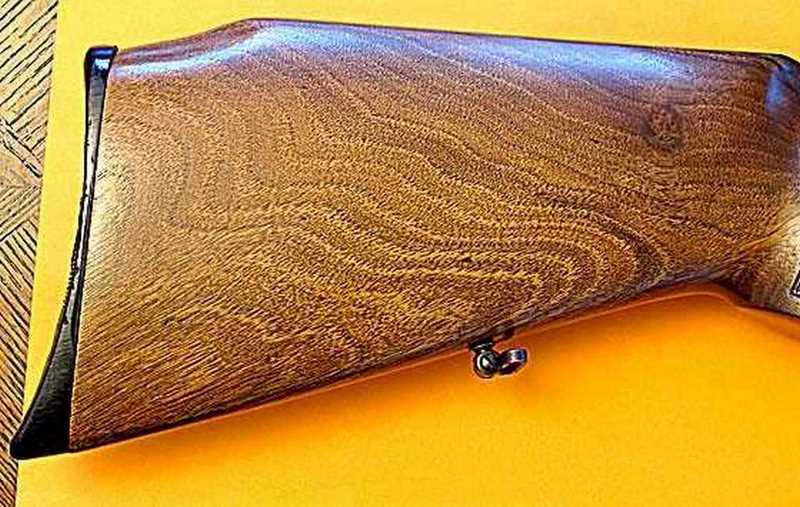
The restored stock shows clear grain on the right butt.
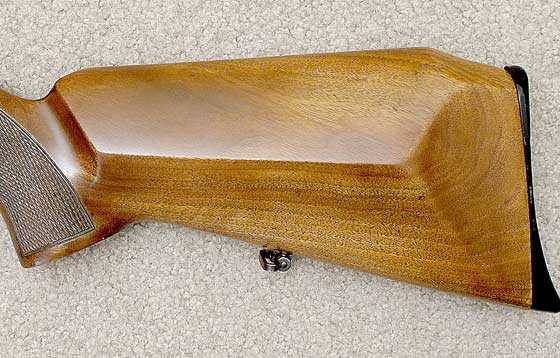
On the left butt, the dents and scratches are gone.
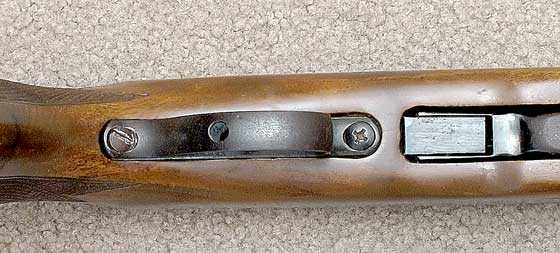
The trigger inletting is the most spectacular thing that was done. Doug Phillips built it up from nothing!
This blog is supposed to be a report about the Falke 90 air rifle — a rifle that, because of circumstances, I’ve never actually tested myself. And when I started to look at it and shoot it for this report, it was very much like discovering that the mousy girl who lives next door is actually a raving beauty. I know I’m hooked, and I have Marv Freund (who initially sold me the rifle), Mac (who originally tested it for me), Kevin Lentz (who told me about Doug Phillips) and of course Doug, himself, to thank for this story.
The report will continue where I left off when this restoration project began. And if any of you have rifle stocks in need of repair, I wholeheartedly recommend Doug Phillips for the work. I purposely have not told you how much he charged for this job because every restoration will be different. If you have an airgun stock or a firearm stock in need of the master’s touch, contact Doug and find out what he can do for you.
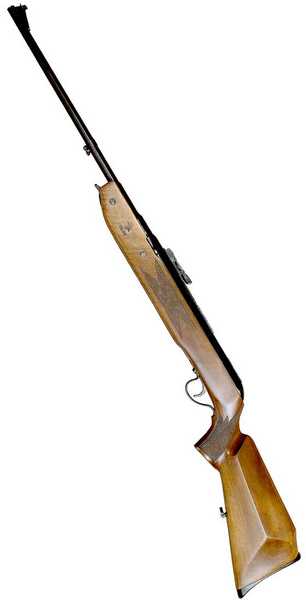
I would say the Falke 90 looks a lot better after the stock was restored!
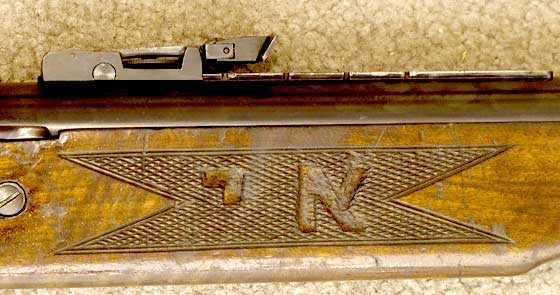
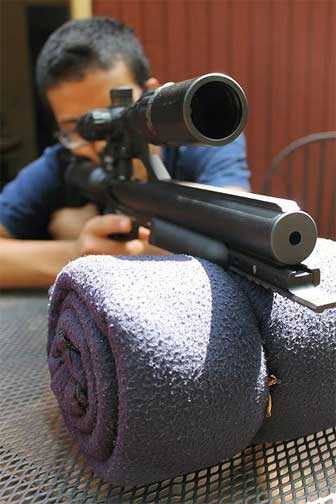
Where exactly did this rifle come from originally? I find it interesting that the initials that had been engraved on the side were block Hebrew letters. Ah, the stories we will never know about our vintage airguns and the people who owned them! By the way, the restoration is fantastic!
Lee
Thanks for clearing that up. I thought that they might be Hebrew letters, either that or Russian. If you know how to pronounce these letters and can spell them out phonetically I would be interested.
As for the Falke, it was manufactured in Bennigsen Germany in 1952 or so. If you are referring to specifically where BB got it from, it was from Marv Freund at a gunshow in Roanoke Virginia in 2010.
Here http://trevormorrisairguns.synthasite.com/falke-modell-90.php is a link to another fine example of a Falke 90. This one appears to be like new, and with the optional peep sight. You will notice at the bottom that the highest known serial number for this gun is 235 which makes it exceedingly rare.
Lee A.,
Please tell me more about those Hebrew letters. Do they have any significance?
The rifle came to me from a blind gun collector, through an airgun collector friend of mine. Neither of those men did the initials, so where they were put on has been lost.
I am gathering material for a feature article about this rifle for “Shotgun News” and knowing the significance of the letters, if any, would really help.
B.B.
Slinging Lead and B.B.,
I never thought that my hobby of airgunning and my profession of dealing with biblical Hebrew texts would ever intersect. Go figure…
As for the letters, they are read from right to left, the opposite of English. Hebrew is a consonantal alphabet, which is to say that all of the letters are consonants. Vowels, if they are used at all (many modern readers of Hebrew are adept enough to read the text without them) are comprised of a system of small markings (which resemble dots and dashes) that appear either above or below the consonants.
The first letter on the right is an aleph (pronounced “a-lef,” with a short a and short e sound). In both biblical and modern usages, it is essentially silent, taking on the sound of whatever vowel with which it appears. The second letter on the left is a yodh (pronounced “yod” with a long o sound). It sounds very much like the letter y in English and, also like the letter y, sometimes functions as a vowel.
The significance of these letters on the gun stock are a mystery to me. I suppose that they could have been the initials of a former owner, which would suggest that a Jewish individual had once owned the gun. Naturally, that would be quite possible since the gun originates from Germany. The form of the letters is a modern, block type rather than cursive. (If you use Microsoft Word, set the font to Ariel, then go to “Insert,” click on “Symbol,” you can look at the Hebrew letters on the menu; the aleph, which is the first letter of the Hebrew alphabet, should be quite recognizable). That suggests to me that the inscriber was familiar with seeing Hebrew text in print. Beyond that, I can’t be sure of much. It is, however, as old as this gun is, truly fascinating to think of the hands through which it may have passed.
Lee,
If I’m not mistaken – and I may be mistaken – abbreviation “aleph-yod” in Jewish mysticism symbolises something like “God’s will” or “God wills (it)”. So, it may be a good inscription for an instrument of precision.
duskwight
Leer A.,
Than you so much! When you said they were Hebrew letters I became concerned that I might have desecrated an inscription that was meant to be a holy saying. With Duskwight’s comment I think that it wasn’t quite that important. But just to know there was meaning and possibly a link to the origins of the rifle is wonderful.
Thanks,
B.B.
B.B.,
Glad to be of service. The Hebrew letters were definitely fascinating, even if their full meaning for the gun’s former owner aren’t clear. By the way, since we are the subject of stock repair, what would you recommend for fixing slight nicks and scratches in the stock of an FWB 124?
Lee A.,
Let’s let Kevin or someone who is qualified comment on that. I would just rub the stock down with Ballistol.
B.B.
Lee A.,
RE: “what would you recommend for fixing slight nicks and scratches in the stock of an FWB 124?”
My first recommendation would be to leave it alone since it’s evidence of honest use and the slight nicks and scratches are part of what makes a gun vintage. Proof that you have a gun worthy of use not just sit idle.
If the nicks and scratches bother you then here’s some suggestions.
IF your FWB 124 has the original finish it has a factory varnish sprayed on the outside of the stock. Tougher than oil to repair. It’s important to know if the finish has started to crackle or craze (does it look like an alligators skin on close examination?).
Assuming the finish hasn’t started to shatter too badly here’s a quick way to minimize, not eliminate, the slight nicks and scratches that you see.
Buy some Klean & Brite. Here’s a link (DO NOT buy the arrow wood refinisher unless you need to refinish another gun) scroll down below the arrow wood refinisher to see the Klean & Brite:
http://mpi.websitewizard.com/ArrowWoodFinishandKleanBrite.html
Get some 0000 steel wool. Don’t buy the 0000 steel wool sold at hardware stores, home depot, lowes etc. It’s too coarse. Buy the 0000 steel wool from a woodworking store. Take the action out of the stock. Working in small sections on the stock dip the steel wool in Klean & Brite, rub with the grain of the wood on your stock and don’t press down hard on your stock. What you’re doing is flattening the old varnish, removing dirt and sweat from the stock and blending the old finish into your nicks and scratches. Use a clean 100% cotton rag to wipe the area you’ve just cleaned. Do this over the entire stock.
If you’re not satisfied with some of the scratches and dings after this treatment then get shoe polish that matches your stock and rub this into your dings and scratches. Let dry. Buff off.
kevin
Hebrew usually means Jewish, so I would guess that one owner of the gun was likely Jewish. I’d wonder if this gun came from Israel at some point. It might have been something a kid was given as a gift and likely they grew up learning to shoot with it. That would be my guess. I don’t know of a whole lot of people that use Hebrew other than that.
Wow. Doug Phillips turned a burlap sack into a silk purse. The repaired cuneiform in the for stock, is nothing short of fabulous. I love the way the grain shows up on the cheek piece. I really think this is one of the nicest cheek pieces I have scene. I think you made the correct decision when you said you wanted a lighter finish that wasn’t shinny. This is a gun that would deserve a centre place in anyones collection. I don’t even care to know the cost of this restoration. Besides coming under the heading of ‘none of my business’, it is truly priceless. Congratulations B.B. You must be walking two feet off the ground with an ear to ear smile. I bet Doug will rightfully have a tad more work in the future. Oh yes, we can’t forget Keven’s roll either. He was the man that lit the flame and got the ball rolling. Just gives me a few more reasons I cherish this blog.
Caio Titus
Been anxiously awaiting this report with some slight trepidation since this stock restoration had significant structural issues, had advanced cosmetic problems, Tom/B.B. has extensive experience with what constitutes average vs. great repairs, average vs. great refinishing and with my recommendation of Doug (without reservation) it put my neck on the chopping block.
The rebuilding of the wood foundation for the trigger plate, reinforced by a metal plate and deftly pulling the wood together to reintegrate the stocks structure (as shown in the second to last photo where the huge split in front of the trigger guard has all but disappeared) is the most amazing part of this restoration to me. Candidly, this artisan is on par with those that can restore a damaged Van Gogh but is more skilled since he must work in 3 dimension.
The stock finish turned out very well. That old shellac over stained varnish was obviously the result of multiple owners that had good intentions but no knowledge. The choice of a new light finish in a complete restoration/refinish is correct. It clearly shows the brilliance of the stock blank choice for this rare gun. In my opinion, it was no accident that the perfect blank with ideal grain was choosen for this rare gun. It not only runs almost perfectly parallel to the action but it was cut to a perfect dimension to symetrically encompass that bayern style face plate. Gorgeous now that you can see the grain pattern.
That Falke 90 is a very special gun that has now been given a new lease on life. It’s one thing to make an old gun look good but it’s a whole different dimension (and cost) to make the gun functional by going the extra mile with your repairs. Tom is to be commended for returning this rare gun to it’s ability to shoot not just look good hanging on someones wall.
Lastly, I almost feel compelled to write my first guest blog which would be titled, “How to ship guns to improve your odds that they arrive without damage”. 😉
kevin
Kevin,
I told on myself because I did a very stupid thing. After properly packing the stock against all possible damage, I just got lazy with the action. It went double-boxed and padded with bubble wrap, but it obviously wasn’t enough.
When Doug showed me the damage I knew I had to tell the story on this blog, because it might educate others who might get careless like I did.
B.B.
Hey Kevin, when Tom mentioned your name I knew I had to do a Good job.
Friends don’t let friends down, especially when they vouch for you.
doug,P. DamagedWoodStocks.Info
Mr. Phillips,
Never hesitated to recommend you. The work you did on my stocks was nothing short of stunning and I know good stock work.
What you did on this Falke 90 is first rate. You have deservedly received accolades from other gifted stock refinishers (heywood, Marc) comes to mind, but after seeing your magic performed on this wreck you’ve been elevated to the POPE of woodworking in my short list of recommendations.
Well done Doug. Thank you.
kevin lentz
G’day BB
Why didn’t he just build you an exact copy. It probably would have been quicker! Nice job!
Cheers Bob
A quite fantastic job!
BB,
I was definitely wrong when I said don’t refinish it. It is a beautiful, classy restoration! It turned out really well! 🙂
/Dave
/Dave,
I am normally against restorations. myself, but this stock was so far gone and the gun so rare that I knew it was time to make an exception.
B.B.
Whoa!
What an amazing job Doug did!! Thanks BB for reporting on this. I wonder now how many new clients Doug will pick up in 2013? 😉
Chris S.,
I hope that it’s a lot! A man who does work like this deserves to have a line of customers.
B.B.
Excellent Mr. Gaylord! Since you are both in Texas, I say owe him a nice Texas steak on top of the payment! 🙂 Very beautiful and well executed repair. Not only did he make look better, the reinforcement is top notch as well.
Well done!
ATB, Chris
B.B.
That’s a great job of fixing up a very trashed out stock. You and Vince end up with some tough cases.
twotalon
Howdy Mr. B.B., Ms. Edith & The Gang, When it comes ta airguns, don’t know enough ta know what I don’t know, but do know a little about woodworking. That job is old skool cool. Modern tech with an artists craftmanship. A restored knuckle, beautiful. Congratz. Have a great weekend ya’ll & thanx.
Beaz
Beazer,
It’s even better than that! It’s a restored 750 KR that belonged to Bart Markel!
B.B.
Thanx for the response, Mr. B.B., I’m honored. IMO, the 750’d be a museum piece. The knuck’d be fer gettin’ all Sunday go ta meetin’ gussied up, weekend puttin’, don’cha think? Side note ta this side note: One of my treasures is a pic of a handshake I shared w/Vaughn Beals @ a local HD dealers new store ground breaking a couple years ago. Sad part was 95% of the “Wild Hogs” there had no clue who he was. Shoot/Ride safe & thanx, sir.
Beaz
Heck, Beaz, almost all riders have no idea who “Black” Bart Markel is, who Cal Rayborn was, who Dick Mann is and so on. (All retired motorcycle racers – first two are former Harley Davidson factory riders, Dick Mann was BSA and Triumph and a great woods rider).
I know who Vaughn Beals is – CEO of HD after the buyout from AMF.
Fred DPRoNJ
Fred,
I watched Bart and Cal race at the San Jose mile track in the ’60s. I saw Cal do a full mile wheelie once!
B.B.
TT,
You may remember that Vince fixed the action of this rifle right after I acquired it. So I’ve had two masters looking after it!
B.B.
Gee, had I known that you were selling this gun
for $250 I might have bought it myself!
Would it be out of line to ask what all this expert
work costs?
Vince,
I’m happy to tell you that Doug gave me a cost of $195, plus $25 return shipping when I showed him the first pictures. I knew he wasn’t aware of how bad the stock really was, so I told him he could change his price after looking at it. He bumped it to $225 plus shipping, which I think is about half of what I expected to pay. And that was before I knew just what an artist he is.
Like you, Doug is a man of honor, and I think he felt responsible for this gun, though I never meant for him to feel that way. I think the work was incredibly cheap.
B.B.
Oh wow! When I saw the photos of the end result it put a big ol’ smile right on my face. I can hardly believe that it was possible to restore the checkered area to that level. A true artist.
Ben B.,
Isn’t it great? I never thought it could ever look that good.
B.B.
Doug’s not another of your Smithsonian friends, is he? If he’s not now you need to get Mac to hook him up. That level of craftsmanship is very rare. I would trust him with Washington’s chair or Lincoln’s bed.
Hey, if you plan on putting the Falke on the table at Little Rock let me know first. It might be worth that $275 now that the ugly crack is fixed.
It is great to get to see craftsmanship like this. Thanks for showing it to us,
David Enoch
David,
Yes, I have every intention of putting the Falke 90 on the table next year. There will be no price on it this time, because I don’t plan on selling it. I just want folks to see what they missed out on.
I feel like the fat girl who turned into a super model after high school, and now I want to go to every reunion 😀
B.B.
In that case, what are your thoughts on rebluing?
kevin
Kevin,
Right now I’m thinking that I won’t do it. The rifle looks good enough, though on close examination, you can see that it has been restored. No reblue, regardless of how good, can change that.
I think I’ll just leave it the way it is for now.
B.B.
Uh… glad you’re getting in touch with your feminine side…
Ok ok ok. I’ll give you your $250.00. Where do I send the check??
Gene
lol
B.B.
Wow, that’s a kind of repair work! Seeing that crack and that carving I would’ve given up and made a new stock. You are a lucky man to have an acquaintance of such an artist.
duskwight
duskwight,
Yes, I am. Why, it’s almost as if I lived in Moscow! 🙂
B.B.
B.B.
Then you’d have to own some good parka, sweater, cap and gloves, warm pants and a thick-soled boots with woolen socks would be nice too 🙂 From what I see in the web it’s almost 20 degrees warmer in Texas than here, but the weather tomorrow is going to be great – arclight-bright sun, crispy snow and almost no wind.
It’s winter at last and outside it’s CO2 fill time: I’m sitting near to the window and it’s close to -14 centigrade less than two yards from me. In the morning when I’ll ride to the range it’s going to be -17. That’s good – the less is the temperature, the less moisture is in the air, the worse it conducts heat – and in fact it does not feel this cold as it could be with -8 and 90% humidity. Frost can be enjoyable if you are properly equipped 😉
duskwight
duskwight,
Yeah, yeah, yeah… When Edith and I moved to Texas from Maryland several years ago we were amazed by the 80 degree F (26.66 degrees C) weather we had in December. Now we expect it. If I can’t wear a short-sleeved shirt outdoors I feel there’s a bizzard at my door.
B.B.
“Frost can be enjoyable if you are properly equipped”
No!
I hate it the only good thing about the cold is getting inside in the warmth of your house.
J-F
Wow” I envy talent like that he is an air gun MichaeL Angelo
GOOD LUCK WITH YOUR NEW AIR RIFLE”
NNJ Mike,
Yep. Talent like that shouldn’t be hidden.
B.B.
BB,
when I saw the first photo of the stock with the “initials”, I immediately recognized them as the Hebrew letters Aleph and Youd. Both Lee and Duskwright beat me to the reply but seeing as my wife is fairly religious, works at a Temple and because of her I’m on a first name basis with something like 4 or 5 Rabbis, let me see if they can confirm Duskwright’s thoughts as to what the abbreviation signifies. Numerically, it’s how you write the number “11” in Hebrew. Of course, Pete Z may weigh in before I can obtain a response but perhaps we can now say that this Rifle is a “Chosen” rifle? 🙂 It can only add to the value, BB.
Fred DPRoNJ
Fred,
Yeah, but did I screw up by removing the initials?
Oh, and thanks for telling me what the initials were in a timely manner. Next time I see your pants are on fire I send you an email! 😉
B.B.
Word back from the Holy folks – other than the number “11”, it has no significance. BB, you may be correct in that it’s the initials of an owner.
Fred DPRoNJ
Fred,
Good report.
Thanks,
B.B.
Unless it was one of a set kept in a Jewish training/range/school… In which case it may just represent a tracking number …
Could be initials; could be a number but probably isn’t. I find it tough to imagine it having detoured through a Israeli in Israel, but could be.
I’ve been reading the blog fairly regularly, but doing a bit of traveling and trying to do some writing.
Cheers,
pete
The gun looks pretty good. I have a decent airgun I picked up in a strange store that sold all kinds of chinese made junk tools. I’ve heard it called an “American camper” on various sites. Kind of cheesy underlever .177 springer but accurate as I can ever want. Problem is it’s just plain old “only a mother can love it” ugly with this opaque orange stain that the chinese just seem to love to slather a gun with. It’s full of drips and runs. Looks kind of like a child painted it, which is likely. I have been thinking of getting some zip strip and removing all this orange monstrosity and putting on a nice walnut stain with a nice clearcoat or perhaps doing a hydro dip. (I do all my own dips in my shop.) Seeing this gun redone is making me want to redo my own monstrosity.
John,
You undoubtedly have a Chinese B3 or a B3-1. Look here to see it:
/blog/2010/08/industry-brand-b3-1-part-3/
The orange color denotes an older gun, or perhaps one made by a smaller company (not Industry Brand).
B.B.
Sometimes the wood under the orange paint is passable. Depends on how much filler they used. In any event, go fer it – you sure ain’t gonna make it any worse!
Well, considering that this is a $25.00 gun from china and not a $3000 custom pcp gun, I suspect you are right. I’m no wood worker but my work is usually pretty good. If they used filler all over it I’ll hydro dip it instead of stain it. It will then become an oddity some kid somewhere will want some day. It’s amazing just what makes some folks want your old junky guns. Do a scull pattern dip or a vietnam camo dip and all of a sudden I got 5 people wanting a gun I couldn’t beg someone to take before.
John,
Okay — NOW you have my full attention! So a painted stock is interesting to some buyers? They turn me off so completely that I never thought about this as a sales tool. I sure have some closet queens that I’d like to move.
B.B.
Some people paint their stocks with bedliner so why not… It’s not my cup of tea either but different strokes for different folks.
J-F
Not painted. Hydro dipping. It’s the same process the big companies are using like gamo and any other realtree stock. They offer real tree, but I offer around 50 different patterns in my shop. I dip AK 47 parts as well as airgun parts. I believe Airforce was thinking of offering their guns with a dip process, but it’s been a while since I heard anything about it.
I have found if I take something like my B3-1 and do something like a nice cano dip I can offer them the thing on one of the used airgun sites and I’ll have at least 5 kids wanting it because it’s camo dipped. It doesn’t make the gun fire any better, but it’s more attractive than an orange gun. It takes me about 2 weeks to do the process properly since I don’t have a professional drying room where I can run 5000 dipped parts at a time.
Yup. That looks like my orange ugly. I did get the gun well over a decade ago so it is definitely not new. It also has a history. It was stolen once. I had written it off as gone forever until the city police had called and told me they had my guns. So after identifying them by serial number I had gotten them back…. all but two cheepies the cops said they had destroyed. They had initially wanted me to come in to sign paperwork so they could destroy the rest, but I wouldn’t have it. Especially my tech force model 66. I wish I couild find the stick magazines for that one. I’ve literally searched the planet and haven’t found spares. Anybody out there have a few they would like to sell?
John.
Contact Pyramyd AIR and talk to Eric Munson. He ran Compasseco and might have some magazines for you.
B.B.
I’ll check him out monday. Thanks for the tip.
I checked out the b-3-1 post indicated. It seems your b3-1 is one that has crappy performance. Mine seems to hit what I’m aiming at. But I don’t use it all that often since I have since moved on to bigger better guns as my budget for guns has gotten more in it. My last one was a hatsan 125th. Big beast, heavy as the main gi=un on an M1 tank but reasonably little recoil or felt vibration. I can’t zero the scope until spring so jury is still out on if it’s reasonably accurate or not. Too heavy for a hunting gun.
I can’t believe the work he did on that rifle. Mike compared him to Micheal Angelo I think it’s more Houdini, that work seems like magic to me.
J-F
Wow, thanks for the pictures, and hats off to Doug, looks incredible, keep his name in the black file
BB,
The initials on the stock were from Albert Einstein, who took up airguns late in life. Just kidding, but wouldn’t the time to check the significance of that time of thing be before you obliterate it?
I didn’t know what to expect when you said restoration. I guess I’m now too used to longrifles where restoration is a lot more conservative. It was kind of a shock to see so much “new”. I’m weird in liking my guns with a story, I suppose, but I wish so much of that particular rifle hadn’t been erased. I could understand the initials being a distraction, but do a few dings really hurt anyone? The triggerguard repair looks great, and the checker re-do is excellent. I know you had a hand in the color, although I bet you really wanted it bleached blond (Edith needs to keep her eyes on you!). I would have stayed with something more like the old color and whatever was a factory finish for those Falkes, but it does look pretty nice now :)!
Tom/Doug,
ASTOUNDING!!!
-Chuckj
Now here is a repair plan after my own heart. Get someone who knows more than I ever could and enjoy his handiwork.
Victor, your mathematical mentor sounds like quite a guy. I have contacted you to hear more but don’t be stingy with any life-changing insights for the blog. 🙂
Today was the day of my definitive test of my Enfield No. 4. And the prizewinner who unerringly predicted the result is…Kevin! The darned gun couldn’t feed anything. The behavior was identical to my snap caps. The bullet nose didn’t reach the feed ramp, and the bolt couldn’t budge them. I guess another winner here is A Zoom snap caps, which perfectly reproduced the performance of real cartridges. I can’t even believe it! How does a gunsmith get a gun and make it worse than before?!! Here we’re drenched with the technical brilliance of Vince and Doug Phillips bringing old guns back to life, and I can’t even get my Enfield to function. The amount I’ve spent on shipping and repairs is already well over the original cost of the gun.
What is disorienting and chilling is how this error came from this guy I’m dealing with. The first gunsmith was a klutz or a neophyte by any number of indications. This new guy is a pro in every way. He went over the gun in great detail, disassembling the safety and going over it with a toothbrush. He not only fixed the bolt function but got it working better than it had before. He also fixed the windage on the front sight and tightened an extractor screw keeping me updated almost by the hour and even scanning in test targets. He even told me that there was a problem with the feed ramp and said he fixed it. So, how does someone like this send back a rifle that can’t feed any ammunition?? Victor, wherein do we find the cause of optimism…?
My range day started in a fair way to be even worse than my usual. I gambled that the cloudy day wouldn’t rain and that worked out about as well as the Enfield. It rained steadily all day long. I tried shooting my Anschutz and was doing all right but I started getting water on the ammo and in the breech and had to close up with nothing more to show than a soaking wet gun. Woodworkers, what’s the best thing to do for a wet stock–and gun? At home the stock felt kind of soggy. Could it rot if left untreated? I took out the barreled action, wiped water off the stock and the action, then sprayed everything down with Ballistol.
To console myself at the range, I fired off 500 rounds, mostly .22 LR, and also 22 WMR and .45 ACP (230gr.) But here things took a turn for the better. My state of mind was by no means the best, but this was one of my best days with the 1911. At five yards, I was putting up to five rounds in a single hole. At 15 yards, I put most of a magazine in a palm-sized area, minus the fingers (except for a few strays). There was very little heeling of the gun. I attribute this to my new-found intuitive follow-through. I was really pinning the eyes into the target through the recoil. Maybe this experience is the basis of the principle of never quitting. You just never know when you might break through.
CowBoyStar Dad, after my experience with the .22 WMR, I have to commend your results. I was shooting a Ruger Single Six which shot out a huge orange flame, much more than from my 1911. I saved this round for the 25 yard range, but I was all over the place. I did much better at the same distance with the .22 LR. B.B., this makes me disagree with your point that recoil has nothing to do with accuracy. It sure seemed make a difference here.
Otherwise, for the afternoon, I chugged along with the Ruger Single Six, one of my very favorite guns. I felt very dialed in at all distances for some reason. The 500 rounds certainly defied the advice of shooting guru Massad Ayoob and even Elmer Keith who say you should limit yourself to about 100 rounds. I was getting shakier towards the end and that final 100 may even have been counterproductive. On the other hand, I was getting good sight pictures and follow-through right until the end.
Matt61
Matt,
I’m sorry to ask this, but I have to. If you don’t know what I’m about to say, it makes all the difference in the world.
Are you aware that all bolt-action rifle must be loaded properly or none of them will feed? Those actions that feed rimmed cartridges like your .303 Enfield are the biggest problems.
The heads of each cartridge have to be stacked inside the magazine sequentially, with the first cartridge loaded pushed to the rear of the magazine as far as it will go. The next cartridge is also pushed to the rear as far as it will go, but the rim of the first cartridge stops the second cartridge from going as far to the rear as the first one did. And so on until all ten cartridges have been loaded.
If you do not load the rounds this way they positively will not feed! I am hoping that this may be your problem, and if it is we can all have a little laugh. There is nothing more finicky than a bolt action that feeds rimmed cartridges.
You are not supposed to remove the magazine from an Enfield to load the gun. Leave it in place and load through the top. Forget stripper clips with guns that have rimmed cartridges, because they can set you up for feeding problems.
I have a Remington 788 in 30-30 (also a rimmed cartridge) and the magazine does come out of the gun for loading. But that mag only holds three rounds, so it’s not that prone to mess up. Still, you do have to take care to load the way I have described, or the rounds will not feed.
But the Enfield is always loaded with the mag installed in the gun. Because it is so long it is also a bit too flexible, and if you load it outside the gun the cartridges can hop over each other as the magazine is inserted, setting you up for feeding problems. It is extremely important that the cartridges are stacked sequentially, so the rims do not bind as the bolt feeds them forward.
B.B.
B.B., thanks for jumping into the breach so quickly. You can ask anything you want without apologizing. I have flirted with the idea of removing the Enfield magazine just to know about the function of the gun, but that’s as far as I’ve gotten. I load from the top. Otherwise, it sounds like you’re talking about rim jams. Alas if only this were the problem, but I’m all over that. Even with my Savage 10FP, I learned to slide each cartridge to the rear before loading the next one even though the ammo does not have rims. When I got the Enfield I loaded them the same way, and when loaded singly, the gun worked flawlessly without a single malfunction. I load the Mosin that way and it too functions perfectly. I’ve even learned how to load the Enfield clips with the rims alternating above and below. Sometimes I would have jams, but I learned to clear those easily enough. These aren’t rim jams. Somehow the cartridges are too low so that the nose is not reaching the feed ramp. Well, I’m calling the gunsmith tomorrow bright and early to see what he has to say.
On a brighter note, while cleaning the guns afterwards, I remembered that cool way you showed me to reassemble a 1911 by catching the swinging barrel link. I had my doubts about remembering since it had been so long, but everything fell into place, and gone is another source of frustration. Once I get this other nonsense out of the way, I’m going to inch forward to reloading for the .45. Such was my state of mind yesterday, that I clean forgot to pick up a single one of the 100 or so .45 cases I threw out although I don’t know if I would have wanted to go rooting around in the rain for them. Anyway, a minor concern. All is well on the 1911 front.
Matt61
For what it’s worth, when you get a new firearm or airgun, shoot it “As Is” before you even think of sending it off for work. This assumes the the gun isn’t broken to start with. After all, “If it ain’t broke, don’t fix it.”
Mike
Matt,
Now you see why I’ve come to like synthetic stocks. If bare wood got really wet anywhere, it might cause a little problem swelling. Probably leaving the action out and letting the wood dry is enough. The worst problem I can see is that the wet wood might swell and split out action screws if they are tight, or the finish might cloud up. Unlikely you got it wet enough for either problem. Leave the action out or at least loosen the screws until you think it is dry, then re-tighten/check the screws before you shoot it next time.
If it makes you feel better, rotting is almost certainly not a concern unless you store it in a damp sack with some manure. That’s all I’d do — whatever damage is done is done. I certainly wouldn’t try to seal any bare areas, especially not until it has time to dry out some.
BG_Farmer, thanks for the expert and rapid reassurance. Actually when I removed the action, there wasn’t as much water as I expected. Maybe the sogginess was from the general ambience of my equipment. There were a few spots of water in the barrel channel. Otherwise, that walnut stock is so massive that I don’t believe there was any penetration of water. No sacks of manure around to cause problems either.
But your description overall with splitting of wood and possible permanent damage makes me realize how utterly crazy and stupid it was to get that gun wet at all for the sake of a few shots. Completely nuts. Thanks to you that gun will never, ever, ever again be exposed to the rain.
Matt61
Matt,
Make sure you throughly dry your gun cases as well. Especially the insides of your gun cases.
kevin
Matt61,
I think that B.B. may have provided the solution, and that fact that possible solutions exist is always cause for optimism. To add to this, I just found that my friends Ruger Air Hawk was not fully treated with loctite, as he assured me. Because it was behaving so badly, I asked if I could keep it until I tried a few things. Because he had assured me that he had applied loctite everywhere, I hadn’t checked for that. The stock screw in front of the trigger guard was not only not treated with locktite, it was dirty and even had some rust. Yesterday I cleaned up the screw and then applied a generous amount of locktite (it’s a long screw).
My reason for optimism is that pretty much every time I’ve encountered a problem with a gun, including firearms, there was always something that I missed. Whereas necessity is the mother of all inventions, ASSUMPTIONS are the mother of all difficult but solvable problems.
Victor
Victor, I myself take pride in loctite which I learned about on this blog. I’ve used it on radio control planes, and I even used it to tighten a thumbscrew on the scope mount of my Mosin. But this problem is way beyond that. Well, we’ll wait for the outcome. Maybe this will be like the parable of Taoism where a farmer finds a bunch of wild horses. Everyone congratulates him but he remains unmoved. His son then breaks his leg trying to ride one of the horses, and everyone commiserates him on his bad fortune. The farmer remains serene. The army comes by and drafts every able-bodied man except for the son because of his broken leg…
Matt61
Matt, I’ve had a love/hate relationship with the .22WMR.
For the life of me 1.5″ groups were the best I could get out of it for the better part of the summer, which had left me feeling I’d made a mistake with all the reports I heard of 1/2″ groups with the .17HMR.
It took all my ‘springer’ experience to finally get it to shoot what I consider good…I can now get 1MAO or slightly better more than 1/2 the time.
First, just like a springer it is extremely ammo picky. I tried Maxi Mags, Winchester, 40gr, 50gr…you name it. By far the best reviews have been for the Hornady V-Max which gave me consistent 1.5″ groups, which I thought was about the best I was going to get out of it. (the Winchester poly tips misfired 50% of the time and gave solid 3″ groups).
One day my gunshop of choice was out of the Hornady and only had the Remington Accutips…the one round I hadn’t tested. And lo and behold it gave me a couple of 1moa groups on my first outing with that round.
So I picked up a few more boxes and headed out to the range when my new Hawke 6.5×20 Tactical came in and hoo-boy, I got a couple of 3/4″ groups. One group had a cloverleaf and the other two shots were no more than 1/2″ off…I was thrilled.
But as I said, it is only my springer training that has allowed this in my opinion. Testing every available ammo, controlling breathing and trigger control. A decent scope with scope level…all these things have to be bang on and then it give good accuracy.
B.B.,
Just dropping you a line that I received the two tx200’s a couple of weeks ago and all I can say so far is wow! Everything that is being said about the fit and finish is true. I got a chrony as well and am planning on having my sons do some comparisons on them as they break in. On a side note, the walnut stocks make each rifle very individual. Both beautiful, but unique like a fingerprint. Glad I went that route. That’s all for now.
corsair45
corsair45,
Thanks for the feedback. I’m glad these rifle met your expectations. I hope your sons will be thrilled with them.
B.B.
You’re out of control. Two TX200s? Well, I must repeat the scene in from Fiddler on the Roof where Tevye is negotiating with a butcher and there is a misunderstanding over whether the butcher is buying cows or asking to marry his daughter.
Tevye: The next thing is that you’ll be wanting two.
Butcher: Two?! What would I do with two?
Tevye: The same as you do with one.
Butcher: ???
At this point, the butcher has an expression that never fails to make me just about die laughing. You should see the original movie. Anyway, congratulations and let’s hear the good news as you shoot the rifles.
Matt61
B.B.
I want to thank you for your reply to Matt on the feeding problem. I never knew this, and in all probability would never have figured it out for myself.
This is really one of the best reasons for reading this blog. Lots of things to learn here, not limited to air guns.
Les
Amen to that!
Hi,
Really enjoy all the tech articles, and many thanks for all your efforts.
Why no details of condition and dimensions, or pics, of the Falke 90 mainspring? Must be weakened after around 60 years, so why wasn’t an original spec replacement tried? That was a 12Ft/lb rifle when new (600Ft/sec with Blue Wasps). Full power testing would have shown different results for the pellet position in the tap. How about trying it and letting us all know? Best regards.
Trev,
I’m not really interested in power in this gun. I have other .22 pellet guns that go well above 12 foot-poundsa. All I wanted with this one was to get it working again.
B.B.